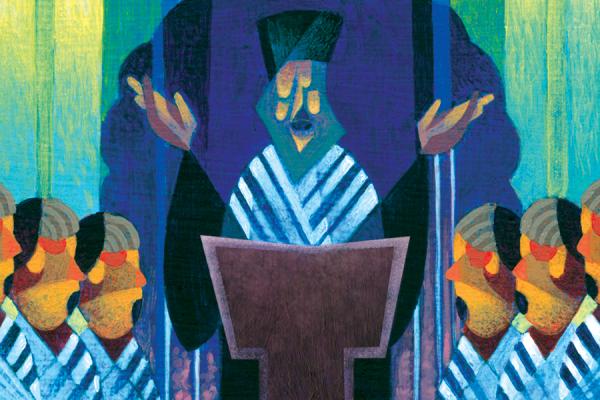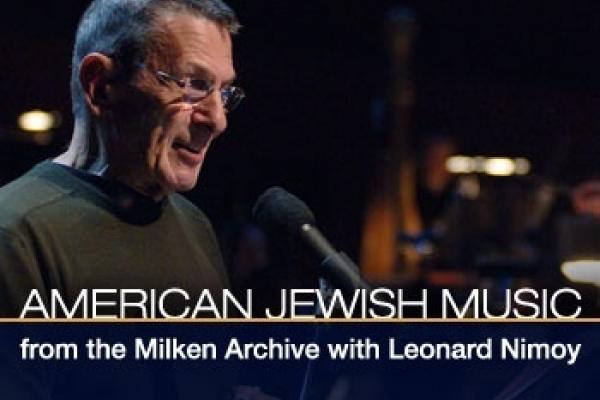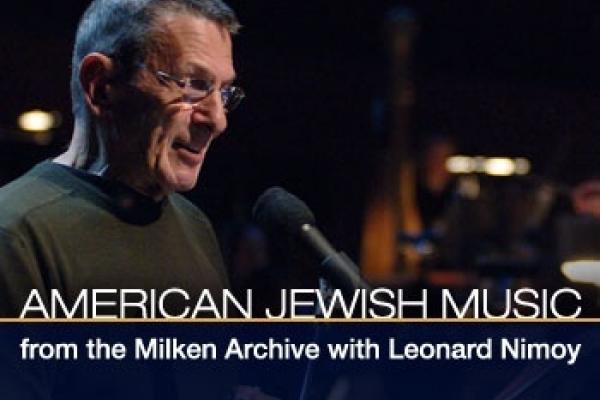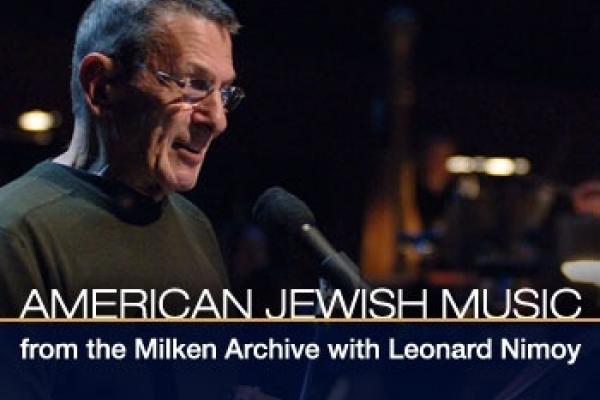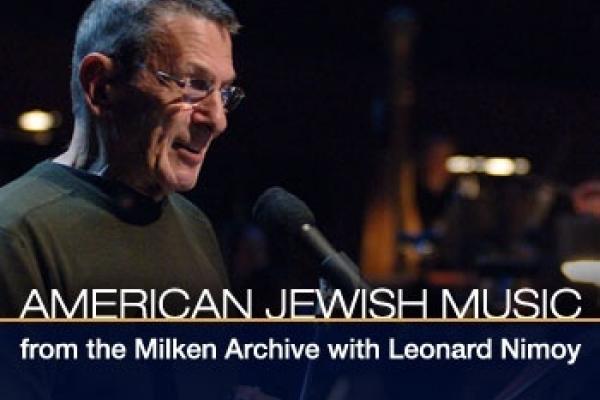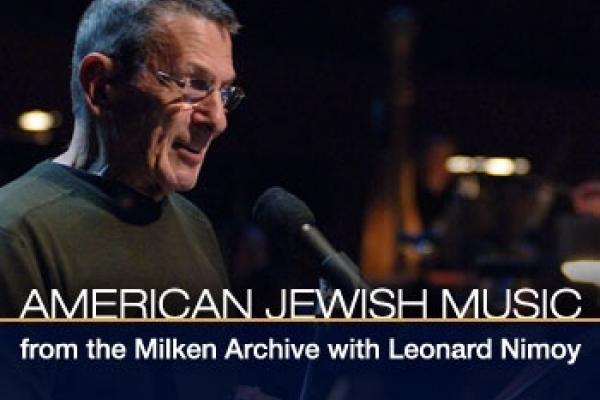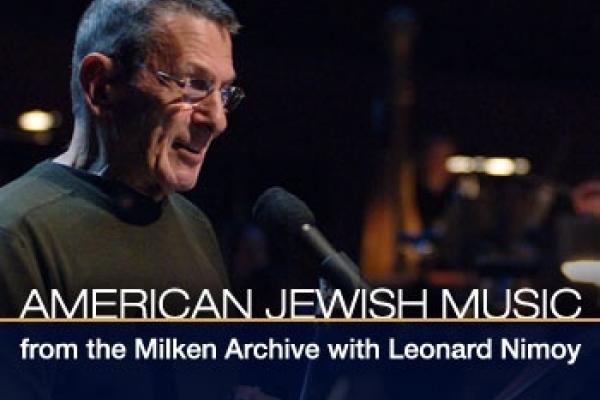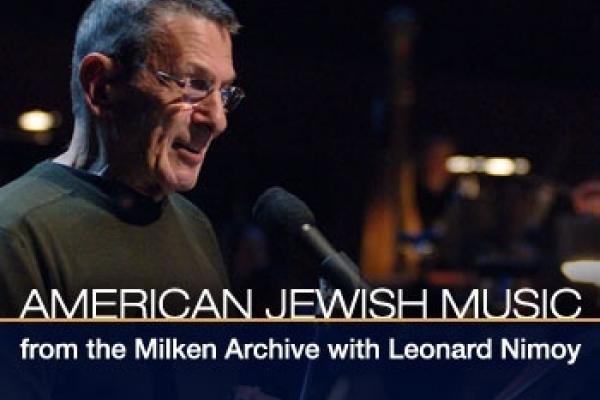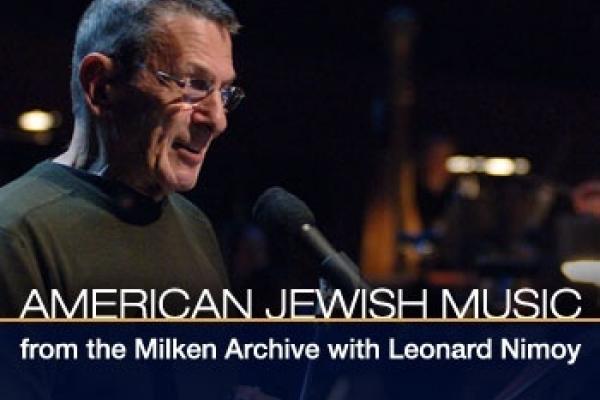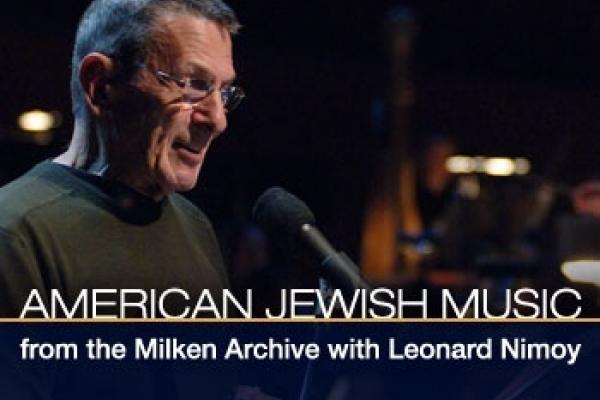Episode 5: Leonard Bernstein
Click on the ![]() icon on the top-right of the video to access the full playlist.
icon on the top-right of the video to access the full playlist.
Episode five features the music of Leonard Bernstein and includes several discussions of how his faith, identity, and relationship with Israel served as a well of creativity and inspiration for some of his most important works.
Episode Transcript
Leonard Nimoy
One Sunday afternoon in 1943, a handsome, talented, 25-year-old Harvard graduate was asked on short notice to conduct the New York Philharmonic in a concert broadcast nationwide on radio. That young man was named Leonard Bernstein. His performance that day electrified critics and the public alike – and for nearly five decades afterward, he continued to astonish audiences with his gifts as a composer, educator, pianist, lecturer, and author as well.
Leonard Nimoy
Hello, I’m Leonard Nimoy. Welcome to another program in a 13-part series that celebrates three and a half centuries of uninterrupted Jewish life in the United States through music, as documented by the Milken Archive of American Jewish Music and issued on CD by the Naxos label. On today’s program: the compositions of Leonard Bernstein -- the most famous and successful American Jewish classical musician of the twentieth century.
Leonard Nimoy
Bernstein is remembered for many things: his Young People’s concerts on television, his score for “West Side Story,” his political activism. Because he loomed so large as a American cultural icon, the quantity and quality of his music on Jewish themes is sometimes overlooked. In fact he composed some twenty works of Jewish inspiration. In a recent conversation, Maestro Gerard Schwarz talked with the Artistic Director of the Milken Archive, Dr. Neil W. Levin, about Bernstein and his music.
Gerard Schwarz
For all of us, Leonard Bernstein was a central figure in the latter part of the 20th century. I remember growing up watching the Young People's Concerts and then, of course, working with him when I was in the New York Philharmonic and then, of course, knowing him quite well after that. More recently, I've become extremely interested in his symphonies. I'm a great fan of Bernstein as the composer, the Age of Anxiety, the Jeremiah Symphony and the Kaddish Symphony. Those three symphonies, I think, are extraordinary works and very important works. When I started looking into the Jewish influence on Bernstein, I noticed that about 25% of his orchestral works have some kind of Jewish theme, and half of his choral music does. So, of course, Neil, how important is his Jewishness, his religion to what he then created, whether it be through his symphonies or through the Ḥalil, through his relationship to Israel itself?
Neil Levin
Well, I think this is a case of somebody who was very complex, and I don't think I would even want to delve into his private beliefs. That's a very Jewish idea, not to delve in, in a way to someone's private beliefs. There is no belief test. I can't tell you for sure what the most pious Orthodox rabbis believe or don't believe or question or don't question on certain levels. In the case of Bernstein, he had a solid grounding in basic Jewish education, which is not true of many composers who happen to be Jews. He was actively interested in and involved in not only Jewish life, but especially in his case, in Jewish history, biblical history in particular, and in Israel, not only politically but culturally. He was interested in the Hebrew language. He was interested in what we called then and still call now, very importantly, cultural Zionism, which doesn't negate political Zionism in any way and certainly it didn't in his case, but the Hebrew language is the major force of cultural Zionism and this interested Bernstein very much.
Leonard Nimoy
Neil Levin, talking with conductor Gerard Schwarz.
Leonard Nimoy
The first complete composition by Leonard Bernstein to survive is a setting of Psalm 148 written in the early 1930’s, when he was still in his teens. We have the chance now to hear the world-premiere recording of that work, made for the Milken Archive and issued on the Naxos label, with mezzo-soprano Angelina Réaux accompanied by Barry Snyder. It will be followed by three other liturgical settings by Bernstein: Y’varekh’kha, based on the priestly blessings from the book of Numbers, sung by Michael Sokol; a prayer from the evening service, Hashkiveinu, with tenor Hans-Peter Blochwitz and the BBC Singers; and a medieval hymn of faith, Yigdal, which occurs in the morning liturgy and also sometimes functions as a concluding hymn of certain evening services.
Leonard Bernstein: A Jewish Legacy
Leonard Nimoy
Samuel Adler led the Rochester Singers and the Eastman Players in Leonard Bernstein’s setting of the medieval Hebrew hymn Yigdal, which is based on Moses Maimonides’ Thirteen Articles of Faith. This musical setting was composed in 1949. Before that: the world-premiere recording of the evening prayer, Hashkiveinu – “Cause us to retire in peace,” with tenor Hans-Peter Blochwitz, organist Christopher Bowers-Broadbent, and Avner Itai conducting the BBC Singers; and Michael Sokol’s rendition of the priestly blessings, “Y’varekh’kha,” with the Eastman Players and organist Aaron Miller. We began with Angelina Réaux’s world premiere recording of Bernstein’s earliest work – a setting of Psalm 148.
Leonard Nimoy
Neil Levin, Artistic Director of the Milken Archive, recalls how the Hashkiveinu setting came into being.
Neil Levin
Bernstein's Hashkiveinu, which is one of the major portions of the evening liturgy both on weekdays and Sabbaths and festivals and holy days all evening services. That Hashkiveinu setting was a commission from the Park Avenue Synagogue in New York, which was for over 30 years one of, if not the major forces in inspiring new music for the synagogue in America and therefore in the world. Through its commissions, cantor David Putterman, who ingeniously devised a program that would commission new music by Jewish and non Jewish composers. By the way, Bernstein brings to the Hashkiveinu...Bernstein he brings I don't know how you feel about it. I think he brings the same rhythmic affinities that you hear in on the Town. I say that in the most positive way. He's not trying to be somebody else. He understands the prayer. He certainly was familiar with the text because this is basic Hebrew liturgy and he was familiar with that. But I think he brings Bernstein to it. I think it's a masterful setting of the piece.
Leonard Nimoy
Neil Levin. In this week’s program from the Milken Archive of American Jewish Music, we’re listening to music by Leonard Bernstein. I’m Leonard Nimoy.
Leonard Nimoy
Rather different from Bernstein’s liturgical music is a group of works inspired by the Zionist ideal and the Jewish State of Israel. Even before its independence, Bernstein admired the idealists who built the new nation, and in 1947 he composed a setting of the Hebrew pioneer song Simchu na by Matityahu Weiner, and a piece called Rina, or “Joy.” His song about the Galilee entitled “Silhouette” was composed for the mezzo-soprano Jennie Tourel in 1951. And in 1958 Bernstein contributed the incidental music to a play by Christopher Fry called “The Firstborn,” produced in tribute to the 10th anniversary of the State of Israel.
Leonard Nimoy
Here, from a Milken Archive recording on Naxos, are The Rochester Singers under Samuel Adler in Simchu na and Rina, and in the Israelite Chorus from “The Firstborn”…and Angelina Réaux performing the song “Silhouette.”
Leonard Bernstein: A Jewish Legacy
Leonard Nimoy
That was the Israelite Chorus from Leonard Bernstein’s incidental music to the play “The Firstborn” by Christopher Fry, performed by the Rochester Singers under the direction of Samuel Adler. Before that, Angelina Réaux sang Bernstein’s song about the Galilee called “Silhouette.” We began with two “chalutz” or Zionist pioneer songs – “Simchu na” and “Rina” – again with Samuel Adler and the Rochester Singers, all on a Naxos release from the Milken Archive.
Leonard Nimoy
Some time before 1956 Leonard Bernstein composed a group of four short piano pieces called “Four Sabras” –the word applied to native-born Israelis. These character sketches are called “Ilana The Dreamer,” “Idele the Chassidele,” “Yosi the Jokester,” and “Dina, the Tomboy Who Weeps Alone.” Here is the first recording – indeed, the first performances anywhere – of “Four Sabras,” played by Bernstein’s long-time colleague Jack Gottlieb.
Four Sabras by Leonard Bernstein
Leonard Nimoy
Jack Gottlieb – a leading scholar of the music of Leonard Bernstein – played the “Four Sabras,” which Bernstein composed in the early 1950’s. You’re listening to a program of music written by Leonard Bernstein, part of a series presenting recordings on the Naxos label from the Milken Archive of American Jewish Music.
Leonard Nimoy
The Artistic Director of the Milken Archive, Neil Levin, spoke with Seattle Symphony conductor Gerard Schwarz about Bernstein’s connection to the State of Israel.
Gerard Schwarz
Bernstein had a very strong relationship to the state of Israel prior to its independence. He cared deeply about it. He premiered a number of works there. He conducted the Israel Philharmonic regularly. What about that relationship?
Neil Levin
Bernstein, regardless of what his other interests and affiliations were, was very, very concerned with the permanence of the Jewish state, as you say, before and afterwards. And he represented something that we never really had before, and that was a conductor who was born a Jew, who remained a Jew openly and proudly and admitted that he was not only admitted, but wrote works and claim. Now, this is a fact of life. We all know that many of the great conductors who came from Europe to the United States were Jews and either converted in Europe or here to Christianity, in some cases, didn't convert, but never made it known or discussed their Jewish heritage. And that includes many of the biggest names. Somebody like Serge Koussevitzky, whose distant relative was one of the most famous cantors and deservedly so of all time. Serge Koussevitzky converted to Christianity. It was practically necessary in those days in order to even be considered by the board of certain symphony orchestras in certain cities. But Leonard Bernstein comes along, who is the quintessential American Jewish boy, young fella, Harvard, studied Hebrew, interested in both religious Jewish life, whether it be Reform movement or traditional doesn't matter.
Neil Levin
And the cultural aspect of Zionism as well as the political aspect of the new state. And he's interested in all these things. And he's very, as you say, he's very proud to be a Jew. And he's writing major works.
Gerard Schwarz
His wonderful work, Ḥalil, was written after the 1973 Yom Kippur war. What does this piece, do you think, mean to him? What does it mean to us as we've listened to it?
Neil Levin
I think Bernstein was probably affected very much by the totality of the Yom Kippur war, by the deviousness of the way it was launched, particularly on the day of Yom Kippur, knowing that the majority of Jews throughout the world, even those who are not that religious otherwise during the year, would be in synagogue and it would be an enormous surprise. And he lost some very close personal friends. The Ḥalil is an ancient instrument of biblical times, but we don't know for sure what it is. Ḥalil, we know from scholarship, is a wind instrument, most like a contemporary recorder or flute. And it's very much associated with the imagined Near Eastern sound of the new settlement in Palestine. It was a kind of romantic attachment to the sound of the Ḥalil.
Leonard Nimoy
Neil Levin, of the Jewish Theological Seminary of America…the artistic director of the Milken Archive. Here is a performance by Bonita Boyd of Leonard Bernstein’s Ḥalil, with the Eastman Players, and Barry Snyder, piano, from a Naxos CD.
Leonard Nimoy
Leonard Bernstein’s work Ḥalil, inspired by a Biblical wind instrument, and played here by flutist Bonita Boyd in a recording available on the Naxos label. This two-hour program, part of a series from the Milken Archive of American Jewish Music, is devoted to compositions by Bernstein, including several world-premiere recordings. In the second half of our program, a new recording of Bernstein’s Symphony No. 3, “Kaddish.”
Leonard Nimoy
Welcome back to this program from the Milken Archive of American Jewish Music, which this week brings you music by one of America’s cultural icons of the 20th century – Leonard Bernstein. I’m Leonard Nimoy.
Leonard Nimoy
The founder of the Milken Archive, Lowell Milken, considers Jewish music to be part of the American experience, as he explained in a recent interview.
Lowell Milken
By listening to the music, understanding the music, we tell much of the story of the past three, four centuries in America. We tell the story of Jewish life in America from a political point of view, from a spiritual point of view, from a communal point of view, from a Zionism point of view, from a social commentary point of view.
Lowell Milken
I think it really has every aspect of looking at the diverse impact of history. And as I say over and over again and I can't say it enough times: The contribution of Jews and Jewish life is really just part of the American experience. It's part of the American culture. It's not independent of the American culture.
Lowell Milken
And only in America would this be the case, which tolerates such diversity and has such a pluralistic society.
Leonard Nimoy
Lowell Milken, chairman of the Milken Family Foundation and founder of the Milken Archive.
Leonard Nimoy
We’ve already listened to some early liturgical settings by Bernstein, and a number of pieces inspired by the State of Israel. As the descendant of Eastern European Jews, Bernstein also felt an attachment to Yiddish-language culture, as exemplified by his ballet “The Dybbuk.”
Neil Levin
The Dybbuk is a theme in Eastern European Jewish folklore and I emphasize just that part of world Jewry, Yiddish speaking Jewry. It's a theme which composers and playwrights and poets and novelists just have not been able to let alone to let go. The Dybbuk is a mythical and mystical inhabitation or habitation of one's body by another spirit. That's essentially what it is, requiring something analogous to a Christian exorcism for which. There is a Judaic ceremony.
Neil Levin
But it's a folk I emphasize it's a folk ritual of non urbanized Jewry of Eastern Europe which persisted throughout even the 19th century. And there are many, many great plays and even films about Dibuk habitations of one's body by the spirit. And that's essentially what the ballet is.
Leonard Nimoy
Scholar Neil Levin. Here is the “Invocation and Trance” from Leonard Bernstein’s music for the ballet “The Dybbuk,” with baritone Patrick Gnage and bass-baritone Jason Smith…followed by a Yiddish setting from Bernstein’s Arias and Barcarolles, “At My Wedding,” sung by Michael Sokol, both from a Milken Archive recording on the Naxos label.
Leonard Bernstein: A Jewish Legacy
Leonard Nimoy
Baritone Michael Sokol singing “At My Wedding,” from Leonard Bernstein’s “Arias and Barcarolles”…preceded by the “Invocation and Trance” from Bernstein’s ballet score “The Dybbuk,” with baritone Patrick Gnage and bass-baritone Jason Smith, from a Milken Archive recording released by Naxos.
Leonard Nimoy
The final selection in this all-Bernstein program from the Milken Archive is one of his best-known works: the Symphony No. 3, subtitled “Kaddish.” Although its title refers to one of the most enduring prayers in the Jewish liturgy, the symphony’s text challenges God, while at the same time acknowledging His sovereignty with praise on a different level. Neil Levin talks about the historical origins of this stance in Jewish thought, in conversation with Gerard Schwarz.
Neil Levin
That's really a libretto or a script that Bernstein wrote, but he drew upon a very well known old Hassidic motif. There was a very famous Hassidic Rebbe means it's not really a rabbi, it's a leader of a Hassidic dynasty. This rebbe was called Levi Yitzchok of Berditchev. The thing for which he is remembered is that he fought with God. But of course, his belief was so strong that he could fight with God. You can criticize your own children, but you don't want anyone else to. It's the same thing he argued with God. He took God to court. He took God to court. He summoned him to a hearing to answer for his not living up to his that is God's part of the covenant of the bargain? Because Judaism is a covenant. That's exactly what it is. It's a covenant between God and the Jewish people. And he said, look, we follow our part. We say Kaddish every day, many times, because it occurs that text occurs in various forms throughout the liturgy. We get up in the morning and we say 13 different forms of I believe with perfect faith. More, much more important than that, we follow your dictums in terms of behavior, in terms of how we treat people, in terms of what we do, and where is your part of the bargain in terms of freeing us from the exile.
Gerard Schwarz
When I connected the kind of symphony with the students at Juilliard before the first rehearsal, I tried to explain to them what the text was about. And I said, for those of you that are believers in God, you will truly understand this text because what true believer hasn't questioned God? For those of you that have never believed in God, it will be an interesting text, but it won't be as meaningful to you. Do you buy that argument of mine?
Neil Levin
No, I buy 90% of it. I think that it's just as meaningful if someone doesn't believe...in the first place, what does believing God mean? I mean, it is impossible to believe without questioning, without doubting. You can believe with perfect faith on one level, but there are other levels and so forth and so on. I think it's just as meaningful to everybody because what is it about? It's about humanism. It's about the humanism of religion. Which I think is part of all great religions. And I think that Levi Yitzchok of Berditchev fascinated. Bernstein precisely because of that, Levi Yitzchok of Berditchev ended up saying, if I ask the English Who's the King? What's their immediate answer? Our King. King Edward is the King, whoever it was at the time. If I ask the Russians, who is the king? They'll immediately say that tsar. But if you ask me who is the King? I immediately say, yitgadal veyitkadash meharba. Which are the first words of the Kaddish. That's the first thing that comes to mind. I say you are the king. So that's after having called God to court to answer, it's a combination. It's like love. Love is complex as well.
Leonard Nimoy
Neil Levin, discussing the philosophical origins of Leonard Bernstein’s Third Symphony, “Kaddish.” Here is a complete performance of that landmark work, newly recorded by the Milken Archive for release on the Naxos label, with Gerard Schwarz leading the Royal Liverpool Philharmonic and its Choir and Youth, with soprano Yvonne Kenny and speaker Willard White. Leonard Bernstein’s Symphony No. 3.
Symphony No. 3, Kaddish by Leonard Bernstein
Leonard Nimoy
Leonard Bernstein’s Symphony No. 3, subtitled “Kaddish,” dedicated to “the beloved memory of John F. Kennedy.” The soprano soloist was Yvonne Kenny, and the speaker was Willard White, in a performance by the Royal Liverpool Philharmonic and the Royal Liverpool Philharmonic Choir and Youth Choir, all under the direction of Gerard Schwarz. This performance was recorded by the Milken Archive of American Jewish Music for release on the Naxos label.
Leonard Nimoy
Bernstein continued composing all his life. Two of the works we’ve heard on this program date from his last decade: Halil of 1981, and Arias and Barcarolles, from 1988. By the time of his death in October 1990, he had become one of the most beloved and celebrated musicians in the world.
Leonard Nimoy
You’ve been listening to another program in a 13-part series devoted to the recordings of the Milken Archive of American Jewish Music, currently being issued on CD by the Naxos label. The Milken Archive was created by Lowell Milken, chairman of the Milken Family Foundation. Neil W. Levin is Artistic Director.
Featured Speakers
 Lowell Milken |  Neil Levin |  Gerard Schwarz |
|---|
Featured Tracks
| Psalm 148; Y'varekh'kha; Hashkivenu; Yigdal |
| Simḥu na; Reenah; Sillouette (Galilee); Israelite Chorus |
| Four Sabras |
| Ḥalil |
| Invocation and Trance, At My Wedding |
| Symphony No. 3 "Kaddish" |
About the Series
| Produced in conjunction with the WFMT network and broadcast on radio stations throughout the U.S., American Jewish Music from the Milken Archive with Leonard Nimoy is a 13-part series of two-hour programs featuring highlights from the Milken Archive’s extensive collection of the musical recordings. Episodes include interviews and commentary with Lowell Milken, Neil W. Levin, and Gerard Schwarz. Radio stations interested in broadcasting the series should contact media@milkenarchive.org. |
Date: June 12, 2023
Credit: Milken Family Foundation
